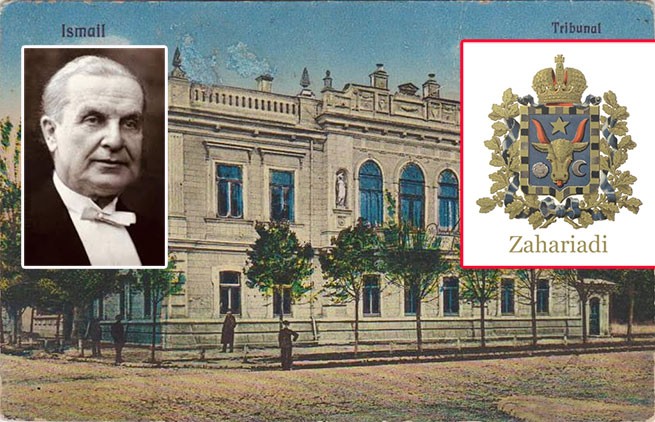In the middle of the 19th century Zachariadi familywhose members were rumored to be distant relatives of the Palaeologus and Comnenimoved, led by her father, the Greek priest Zachary, from Thessaloniki to Izmail to develop trade relations with Russian merchants.
After the end of the Crimean War in 1856, the city was transferred to the Turkish vassal, the Principality of Moldavia. The Zachariadis reacted negatively to this change and became the main force defending Russia's interests in Izmail.
As a result of the administrative reform that took place in the late 1850s, the Principality of Southern Bessarabia was created with its capital in Izmail. Thanks to the help of the Russian ambassador, Zaharija's son Alexander was appointed head of the new territorial unit and given the title of Prince of Southern Bessarabia. He led it for the next few years, from 1857 to 1861, until the establishment of the power of the Romanian King Alexander John I.

Zachariadi was dismissed from his post, but was given generous rewards from the crown. In the following years, father and sons tended their estate in southern Bessarabia.

In 1877, during the turbulent events, A. Zachariadi supported the Russian imperial troops and provided them with significant financial assistance in Izmail. The city, in accordance with the Berlin Treaty, was transferred from Romania to the Russian Empire in 1878 and became part of the Bessarabian Governorate. For the assistance provided on their part, the Zachariadi family received gratitude from Emperor Alexander II and the opportunity to occupy the highest positions in the administration of the Bessarabian Governorate.
Alexander's five sons – Ivan, Zakhary, Pavel, Alexander and Konstantin – became famous personalities. Ivan Alexandrovich, the eldest son, held the post of mayor of Izmail twice. Alexander Alexandrovich owned lands and developed viticulture in southern Bessarabia. He was also a philanthropist and financed the Red Cross floating hospital “Sestritsa”. Konstantin Alexandrovich played an important role in the management of zemstvo affairs.
During the Civil War, the Zachariadi estate in Chumai was burned down. They were forced to leave Bessarabia and flee to Crimea. There, the founder of a new branch of the family was Christopher. It was primarily engaged in agriculture in the small village of Fontany in the central part of the peninsula.
In the 1930s and 1940s, many members of the family were subjected to political persecution. Thus, in 1938, brothers Nikolai Dmitrievich and Pavel Dmitrievich were arrested and executed on a false denunciation to the NKVD. They were rehabilitated between 1956 and 1958.
Another member of the family, Zakhari Pavlovich Zachariadi (1884–1954) was born in Tripoli (then Turkey). He died in the Urals, where he was exiled from Crimea. His wife was named Pinelopi. Their daughter Olga, born in 1932, currently lives in Athens. She is the mother of two children: a son, Christo, and a daughter, Anna, who has since passed away.
One of the last representatives of the family in the USSR was the daughter of Khristofor Georgievich, Anna Zakhariadi. It is known that she worked as a technologist at a wine factory. She died in Feodosia in 1989.
One of the prominent representatives of the Zahariadi family was also Constantine Zahariadi, a Romanian botanist, professor, and discoverer of the plant species Ornithogalum pyreneum.
The memory of the glorious family lives on to this day: in the Danube Museum in Izmail, one of the halls is dedicated to the Greek dynasty. Furniture from Konstantin Aleksandrovich's rooms has been preserved. In addition, memorial stands have been installed in the village of Fontany near Simferopol in the Republic of Crimea.
While paying tribute to our national identity, it is important for all of us to preserve family histories and the memory of our ancestors.
Sources:
Legal sources:
- Law of the Russian Federation “On the rehabilitation of victims of political repression” dated 17.10.1991 No. 1761-1 FZ
- Law of the USSR “On the rehabilitation of repressed peoples” of 26.04.1991
- Resolution of the State Defense Committee of the USSR No. 5984 of June 2, 1944
- Information from the State Archives of the Republic of Crimea
Scientific literature:
- Filatova L.N. The Zachariadi family in the history of Bessarabia // Magazine “Izmail”, 2013
- Blokhin V. F., Kosarev S. I. English press on Russia's policy in the Balkans (1877-1878). Russia and the world. Interdisciplinary seminar on the history of mutual perception of cultures. March 2, 2014
- Lozovan D. D. Ethnogeography and toponymy of the steppe south of Bessarabia. “Questions of steppe studies”, 2018
Fiction:
- Rudenko A.A. Legends of Crimea, Publ., 2017
Internet sources:
- https://ukrainiansmd.wordpress.com/2014/12/25/%D0%BA%D0%BE%D0%BC%D0%BC%D1%83%D0%BD%D0%B0-%D0%B2% D0%B8%D0%BD%D0%BE%D0%B3%D1%80%D0%B0%D0%B4%D0%BE%D0%B2%D0%BA%D0%B0/
- https://ibn.idsi.md/sites/default/files/imag_file/p-179-194.pdf
- http://history.org.ua/LiberUA/978-966-555-072-3/978-966-555-072-3.pdf
- http://www.izmail.es/print_version/article/39816/
- https://ru.m.ruwiki.ru/wiki/Zakhariadi_(genus)
- https://www.greekmos.ru/category/g-family/#:~:text=Zahariadi%20(Zahariadi%2C%20Ζαχαριάδης)%20—, with%20history%20and%20traditions%20family.
- https://m.wikidata.org/wiki/Q13502472
Zahariadi Heritage Family Archive.







More Stories
Who is he – the only Greek god Pan who got into the chronicles of Plutarch, and what does Jesus Christ have to do with it?
How a cuckolded husband in Ancient Greece paid for his wife’s betrayal and what does the donkey have to do with it?
On this day, Koukidis sacrificed himself to stop the Nazis from desecrating the Greek flag.